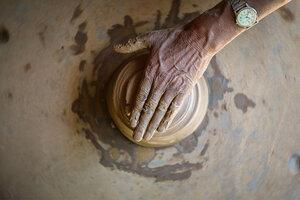In Pictures: Where Kashmiri potters fire an ancient art form

The potter’s craft is mostly passed down through families, with both men and women contributing to the effort. Mehmooda Bano lights a fire to keep the earthen pots warm as part of the curing process.
Sharafat Ali/VII
Srinagar, India
How do you save a historically significant cultural area without displacing the very people who make it unique? This is the situation facing the Kumhars of Banmir village, artisans whose ancestry traces back to the Neolithic potters of the region known as Gufkral (in Kashmiri, gufh means “cave” and kral means “potter”).
Archaeologists, who began excavation in 1981, have found artifacts dating back to 2000-3000 B.C., including polished stone celts (similar to an ax or hoe) and other tools made from stone and bone.
A government plan to conserve the ancient caves would protect the archaeological legacy while threatening to upend the lives and livelihoods of the Gufkral community. The multichambered caverns are not only home, studio, and warehouse to 15 remaining Gufkral households, but also part of the potters’ lineage and identity.
Why We Wrote This
What makes a place worth saving? Kashmiri potters say their ancient way of life gives meaning to caves that the government wants to preserve by relocating the families.
If the families are forced to leave, the area will lose a key cultural resource. It is not the caves alone that are a part of the Neolithic history of Kashmir: The Gufkral community is equally important to understanding these caves as a living system instead of mere dug-out hollows.
The inhabitants have persisted despite the hardships of making a living from their craft. “I have been a potter for the last 60 years, as my ancestors did for centuries,” says Assadullah Kumar. “But our children are now inclined toward new opportunities that would bring a stable income.” Young people are more apt to pursue an education, work as day laborers, or take up farming, he says.
Manzoor Ahmad Kumar (the potters use variations of “Kumhar” as their last names, but they are not all related) grew up working with clay. As the land around the caves is sold off for residential and agricultural purposes, he says the potters face difficulties in obtaining the soil used for their earthenware.
Women as well as men contribute to the family business. Says Mehmooda Bano, “My husband and I work very hard to keep this ancient craft alive.”

